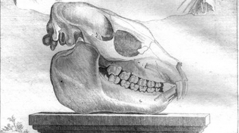

 Zoosystema
39 (4) - Pages 487-499
Zoosystema
39 (4) - Pages 487-499A skull of Procavia capensis (Pallas, 1766) (Hyracoidea, Mammalia), currently on display in the Galerie de Paléontologie et d’Anatomie comparée (Paleontology and comparative Anatomy Gallery) of the Muséum national d’Histoire naturelle, Paris, is here identified as the one Daubenton described in 1767 in the catalog of the viviparous quadruped collections of the King’s Cabinet he wrote for Buffon’s Histoire naturelle (Natural History). While Daubenton clearly recognized in this skull from Sidon, Lebanon, the most remarkable characters of hyracoids, especially the teeth, he could not identify the animal, since the first precise description of the species was published by Pallas at the same time (at the end of 1766). In subsequent volumes of the Histoire naturelle, Buffon repeatedly dealt with the hyrax, on the basis of new data, but he failed to assign the skull of Sidon to this species, although Pallas recognized the nature of this skull as early as 1776. In a volume of the Histoire naturelle published in 1789, after Buffon’s death, this skull was illustrated on a plate and considered as belonging to a primate, the Bengal slow loris (Nycticebus bengalensis (Lacépède, 1800)). Fifteen years later, it was one of the specimens which enabled Cuvier to remove the hyrax from the order Glires or Rodents, in which it was generally placed since Pallas, to assign it to the Pachydermes.
Buffon, Cuvier, Cape Hyrax, Daubenton, History of Comparative Anatomy, Hyracoids, Pallas.